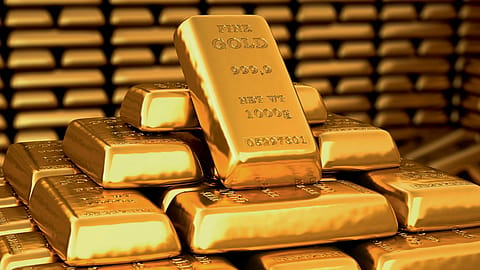Gold stuck in a tug of war between strong U.S. data and rising global uncertainty
In July, gold prices have shown a steady recovery, though remain range-bound.

COMEX gold witnessed a 6.5% correction in the second half of June, retreating to around $3,250 per ounce weighed down by a stronger U.S. dollar and temporary geopolitical relief, as Iran signaled willingness to resume nuclear negotiations with the U.S., easing tensions with Israel. Cooling trade tensions, following Treasury Secretary Bessent's suggestion of a possible extension to the 90-day tariff pause and strength of dollar after the Fed held rates steady in its June FOMC meeting, citing continued economic strength and low unemployment despite upside inflation risks pressure gold prices.
In July, gold prices have shown a steady recovery, though remain range-bound. A weaker U.S. dollar, amid concerns over the ballooning fiscal deficit, supported prices. The Senate's passage of a key spending bill, with Vice President JD Vance casting the tiebreaking vote, and heightened trade policy uncertainty, also added to bullish sentiment. Meanwhile, Trump escalated trade tensions by announcing steep reciprocal tariffs, up to 70%, effective August 1, unless bilateral agreements are reached.
Additional tariffs of 35% on Canadian goods, 50% on copper and Brazilian imports, and 30% on EU and Mexican products fueled safe-haven demand. Geopolitical concerns lingered, with little progress in Russia-Ukraine talks. Meanwhile, Trump’s criticism of Fed Chair Powell and demand for a 3% rate cut increased policy uncertainty. Despite easing fears from improved U.S.-Vietnam trade ties, unresolved negotiations with Japan and threats of new tariffs remain risks. Strong central bank and ETF demand continue to support gold, with H1 ETF inflows reaching 397 tons, the highest in five years, and significant purchases by China and rising Swiss gold exports. China’s central bank added 70,000 troy ounces to its reserves in June, marking its eighth consecutive monthly purchase.
Gold prices have faced some headwinds recently as the U.S. dollar strengthened and Trump eased concerns over Federal Reserve leadership. In a press interaction, Trump clarified he is “not planning” to fire Fed Chair Jerome Powell, though he reiterated criticism over high interest rates, labeling Powell’s performance as “terrible.” Despite the lack of fresh momentum, gold remains firmly above $3,300/oz, supported by persistent geopolitical risks and investor caution toward dollar-denominated assets. Also, concerns over political interference in the Fed and uncertainty regarding Fed Chair Powell’s tenure still lingers.
Economic data has added complexity to the outlook. June retail sales rose 0.6%, reversing a 0.9% drop in May, suggesting a modest rebound in consumer activity. Initial jobless claims also fell for the fifth consecutive week to 221,000, lowest in three months, underscoring labor market resilience. These economic data, along with easing factory inflation, reduce urgency for rate cuts. However, CPI remains elevated at 2.7%, while core CPI stood at 2.9%, still above the Fed’s 2% target.
With inflation still sticky and economic indicators firm, the Fed is expected to hold rates steady at 4.25%–4.50% in its upcoming July 30 meeting, with a 95% probability of a hold. Comex Gold is currently trading below $3,350 as stronger U.S. data supports the dollar. While the potential for trade normalization could curb gold’s momentum, safe-haven demand remains resilient amid renewed trade tensions, Middle East instability, and the prolonged Russia-Ukraine war, keeping the long-term outlook for gold fundamentally supported.
Technically, Comex Gold is holding key support at $3300, with a broader support zone between $3270- $ 3220. A breach below $3220 can lead the prices towards $3130. On the upside, sustained momentum above $3400 could push prices beyond $3510 could create new high near $3650. On MCX, 96,300 is the key support area, while a breakout above 99,500 could trigger a rally towards 1,01,600.
Recommended Stories
Comex silver futures have surged to a 13-year high above $39.50/oz, rallying over 9.7% in the past month amid escalating global trade tensions. Meanwhile, MCX silver also hit a record high above ₹1,15,000/kg driven by safe-haven demand after Trump imposed steep tariffs, 35% on Canadian and 30% on Mexican imports, with Mexico being a key silver exporter. Trade uncertainty with the EU further fueled investor caution. Silver now leads precious metals with a year-to-date gain of over 30%, outpacing gold’s 26%, amid rising inflation concerns and tightening physical supply.
The gold-silver ratio has declined to 86, reflecting silver’s relative strength. Silver also found support from signs of resilience in the U.S. economy, which reinforced its dual role as both an industrial and safe-haven asset. Beyond macroeconomic drivers, silver's long-term outlook remains bullish, supported by robust industrial demand from the clean energy sector particularly solar and semiconductor industries which continues to attract substantial investment despite broader trade-related challenges.
(Kaynat Chainwala is the AVP, Commodity Research at Kotak Securities.)